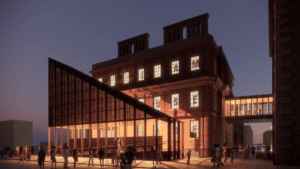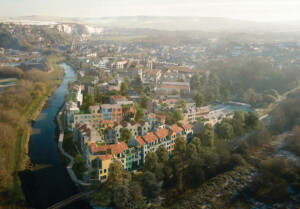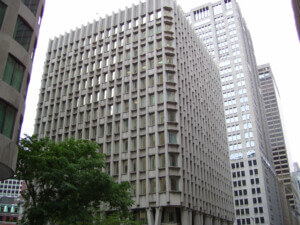Dunelm House in Durham, U.K., more commonly known as the Durham Students’ Union, is facing an ominous future. The Department for Culture Media and Sport (DCMS) told The Architect’s Newspaper (AN) that the Secretary of State, Karen Bradley, “is minded to issue a Certificate of Immunity from Listing (COI).” A campaign, though, is trying to save the building.
Durham University applied for a COI in April last year and then launched a competition calling for a redesign of the concrete structure. In December, Bradley neglected calls from Historic England to award the Brutalist, 51-year-old building Grade II listing status. The university argues that adapting Dunelm House would be too expensive, costing an estimated $18 million.
For many, however, news of what appears to be the building’s impending demise will be sad news. Brutalism has roots in Durham—Peter and Alison Smithson met there while studying architecture at Durham University. Aside from that quirk, Dunelm House has won significant praise. In its year of opening, the building won the 1966 RIBA Bronze Medal and the Civic Trust award. In their statement, however, the DCMS said: “Having considered advice, it has been decided that Dunelm House does not meet the special architectural or historic interest requirements for listing.”
Designed by the Architects’ Co-Partnership, Dunelm House was engineered by Ove Arup. In material and form, it compliments Arup’s Grade I listed Kingsgate Bridge–a structure which was completed in 1966 also. Kinky detailings, such as the arrangement of chains found attached to the concrete are unique and fun (words not always associated with Brutalism). They are also a visual joke–way before postmodernism came along–of tying the building down.
Slopes which make for great section drawings are in response to the topography of the site which dramatically veers down to the River Wear’s banks. They also maintain views of the impressive 937-year-old Durham Cathedral which rises above the trees forming a landscape coalesced by the Kingsgate Bridge.
Speaking to AN, post-war British architecture historian and author of Raw Concrete: The Beauty of Brutalism, Barnabas Calder reacted to the DCMS’s statement:
This is very clearly a building which, as Historic England recommended, should be listed: It is a superb example of 1960s university architecture, in which Britain led the world. Even the university’s own argument that it is too expensive to repair falls down on the fact that it will cost a good deal more to replace it with anything worth having. I can’t understand why the DCMS has decided to overturn the advice of the experts at Historic England, and their statement does nothing to answer the question.
Dunelm House is an exceptional piece of Modern architecture—sensitive yet bold, original yet full of rich references to the great architecture of its period… If the university thinks it can get half so good a new building on the same site for less than the cost of repairing Dunelm House it’s living in a dream.
Christopher Beanland, author of Concrete Concept: Brutalist Buildings Around the World, also gave his thoughts on Dunelm House:
Clearly, it’s a significant building that works in its surroundings. You look at it and initially think – yes it’s aggressive, yes it’s attention seeking, yet that part of the River Wear is a very peaceful place and the more time you spend there watching the students on bikes or in boats the more it seems friendly.
A petition to help save the building is available online here and naturally, there is a “Save Dunelm House” Twitter page.










